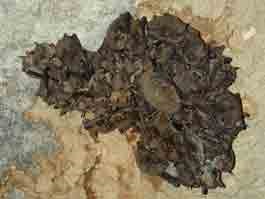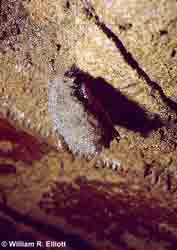|
by William R. Elliott and Richard L. Clawson Courtesy of Missouri Department of Conservation P.O. Box 180 Jefferson City, MO 65102-0180 Many people have asked us how to identify bats roosting in caves. Most published bat keys are based on physical characteristics that can be seen only by handling the bat. No one should handle bats or get too close to them unless one is a) a biologist conducting research, and trained to handle bats safely (both to the human and the bat), and b) vaccinated against rabies. It is possible, however, to accurately identify most bats in caves without unduly disturbing them. We have constructed this guide to the common Missouri cave bats using behavioral, environmental, and physical characteristics such as clustering, coloration, posture, preferred microhabitat, and so on. The sizes of the various bats will be presented in comparison to the eastern pipistrelle because pipistrelles are found in nearly all of the caves of Missouri and thus are familiar to most cavers. This guide is primarily designed for the colder months of the yearly cycle because six species of bats commonly hibernate in Missouri caves, but only the endangered gray bat occupies caves in any numbers during the summer. Note: Please do not disturb roosting bats. If you encounter a large colony you almost certainly have stumbled upon endangered bats. Their populations have declined despite their clustering behavior. Please do not shine your light on the cluster(s) of bats, and leave the area quickly and quietly. Bats are under stress right now. There is a new disease called White Nose Syndrome is killing huge numbers of bats in the United States. It has now spread into Missouri. Read more and see a map of White Nose Syndrome's spread here. Watch the video series Bats in Crisis, about White Nose Syndrome in the National Parks. We hope this guide will prove useful. Please give us your comments! At or Near the Cave Entrance Big brown bat: Largest bat in Missouri caves (several times larger than the eastern pipistrelle); common in winter, likes attics in summer; frequently roosts singly in holes in cave wall or ceiling, may be in pairs, sometimes forms clusters (of up to a dozen) during severe cold snaps; long, glossy, dark brown fur; ears broad with rounded tips; dark, dog-like muzzle; tragus (flap inside ear) broad and rounded. Twilight Zone and Farther into Cave 
Indiana bat (endangered): Slightly larger than the eastern pipistrelle; usually roosts in clusters but may roost singly; forms large, dense clusters up to 300-400 per square foot, sometimes of hundreds or thousands of bats; fur brown with a reddish/pinkish tone; belly fur lighter than back fur, but not a strong contrast; overall appearance of fur and membranes dull, not glossy; pink nose sort of flattened; vulnerable to disturbance during hibernation (arousal causes the depletion of fat reserves); not in caves in summer. Gray bat (endangered): About twice the size of the eastern pipistrelle; hibernates in very large numbers in only a few, vertical caves; forms looser clusters than Indiana bats but common habit of bats hanging upon other bats produces multiple layers in some clusters; frequently hangs with wings unfolded; fur uniform medium gray but bleaches to reddish by spring and early summer; summer colonies form in caves in river valleys or near lakes; makes large guano mounds in summer caves; highly vulnerable to disturbance during all seasons (arousal during hibernation causes depletion of fat reserves; disturbance of maternity colonies causes panic and may produce mortality of young). Little brown bat: Slightly larger than the eastern pipistrelle; may roost singly, in pairs, or in clusters of a dozen or more bats, likes attics in summer; fur medium to dark brown, glossy highlights; belly fur distinctly lighter than back fur; dark forearms with chocolate brown wing membrane; overall appearance of fur and membranes glossy; fur sometimes covered with condensation. Northern long-eared bat: Slightly larger than the eastern pipistrelle; often roosts solitarily but sometimes in small clusters of 5 or 10; frequently tucked into holes in ceiling or tight crevices in formations; ears proportionally longer than other common bats (15-19 mm or 2/3-3/4 in) but less than the big-eared bat; tragus long, narrow, and pointed. Warmer, Interior Cave Passages 
William R. Elliott, Missouri Dept of Conservation Eastern pipistrelle: Small bat; usually roosts singly, sometimes in pairs, and rarely in clusters of a few to a dozen bats; pale reddish to yellowish fur; often covered with dew drops; forearms distinctly pink and contrast strongly with black wing membranes; small ears; tip of tragus rounded; typical posture is to appear hunched or rounded; common in winter. Very Rarely Seen in Caves Eastern red bat: About twice the size of the eastern pipistrelle; only seen singly (and seems to hang in place until it dies); fur reddish to yellowish, frosted; white ruff under chin; ears rounded but lacking black margins. One bat species that is now missing from Missouri caves is the Ozark big-eared bat. This endangered subspecies has huge ears up to 45 mm (1 3/4 in) long. It was found in a few small caves in southern Missouri and still exists in Arkansas and Oklahoma. The southeastern bat and the eastern small-footed bat occur in Missouri, but in very low numbers. The Mexican free-tailed bat occurs in parts of western Missouri in the summer.
|
Last updated: January 14, 2020
